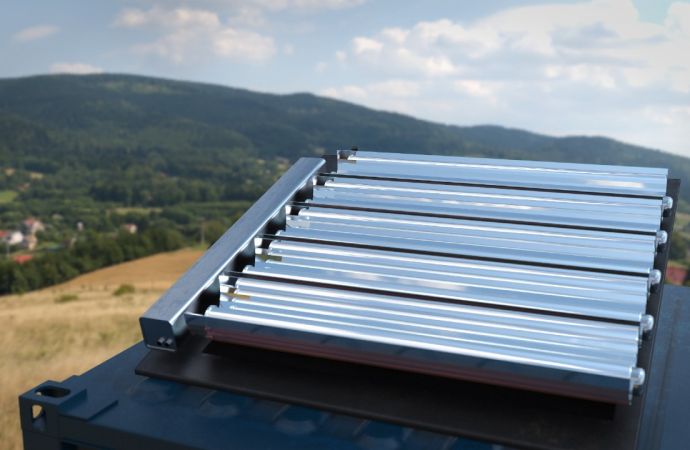The system from Solar Polar delivers low-cost, off-grid cooling opportunities using very small ammonia charges.

The solar collectors from a Solar Polar unit. Photo credit: Solar Polar.
Solar Polar, a U.K.-based startup, has developed a low-cost, off-grid cooling and air conditioning system based on solar-diffusion absorption-refrigeration (DAR) technology that incorporates ammonia and hydrogen.
The Solar Polar cooling system needs no electricity or water to run; it relies only on the heat from sunshine. Solar Polar is currently working to commercialize the product, with field trials taking place in India and Florida (U.S.).
The company has used the refrigeration solution to create three options:
- MedBox is a modular cooling system to preserve vaccines and other medicines in off-grid locations;
- CropBox aims to provide refrigeration for crops in the developing world. This also consists of a number of modules, each connected to a refrigerator, depending on the cooling demand;
- CoolBox is for air conditioning of buildings. These modules can be mounted on roofs, walls or in open air.
In addition to the obvious benefit of being able to run in areas with no grid electricity, and needing no electrical parts like a pump to move the cooling solution around, the Solar Polar system is long lasting and very low maintenance, the company’s website states.
Individual modules of the Solar Polar system have a capacity of 0.2kW (0.057TR) and an ammonia charge of less than 0.5lbs (0.23kg).
In addition to being patented, the refrigeration module has won awards from Innovate UK and Engineers Without Borders.
Low-cost system
The beginning of the Solar Polar system saw Robert Edwards and Michael Reid carry out their R&D entirely self-funded. In 2015, the pair secured a patent for their system, and later grants from the EU’s Horizon 2020 funding program, to continue the development.
The system does not have a significantly high coefficient of performance (COP), but due to the mechanical simplicity, and the “free” sunlight driving the process, the system still has a lower cost than a “standard single-effect cycle,” according to Vikas Patnaik, Vice President for Product Development at Modern Electron, who spoke about the Solar Polar solution at the online IIAR Conference in June.
“[The Solar Polar solution] becomes very appealing in a mass market sense, especially in parts of the world where the electrical infrastructure is underdeveloped, and where the economy is primarily rooted in agricultural production,” Patnaik said.
How does it work?
In the Solar Polar system, water-filled solar thermal collectors harness the heat from the sun, transferring the hot water via pipes to a generator where the heat is used to boil a water-ammonia solution.
The resulting gas is raised through a so-called bubble pump to a rectifier, which separates any water vapor from the ammonia gas and returns it to the generator using gravity. The purified ammonia gas is then led through a condenser.
In the upper part of the condenser, the condensed ammonia gas is mixed with pure hydrogen. The law of partial pressures then causes the ammonia to evaporate and cool the air within the system.
The hydrogen-ammonia gas is led to an absorber, where it meets the water passed down from the rectifier. The water re-absorbs the ammonia and returns to the generator. The now pure hydrogen travels back to the evaporator.
A full diagram describing the process can be found here.
The cold air created by the process is funneled out into the refrigeration unit or space that needs cooling. The hot air created around the condenser is rejected back into the atmosphere.
The Solar Polar system also creates condensed water from dehumidifying the air. This water can be tapped out of the bottom of the unit, and in areas where water is scarce, can be used to water plants or boiled for human consumption.
The solution also provides the ability to add thermal energy storage, for times when cooling is not needed.[The Solar Polar solution] becomes very appealing in a mass market sense, especially in parts of the world where the electrical infrastructure is underdeveloped, and where the economy is primarily rooted in agricultural production,” - Vikas Patnaik.
Want to find out more, or have something to say about this story? Join the ATMOsphere network to meet and engage with like-minded stakeholders in the clean cooling and natural refrigerant arena.
Related stories



